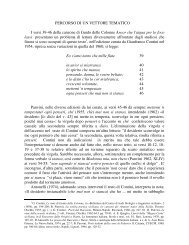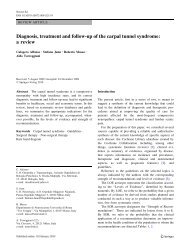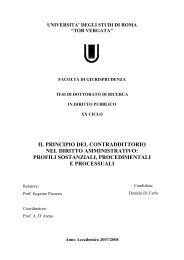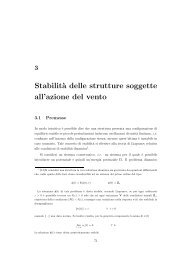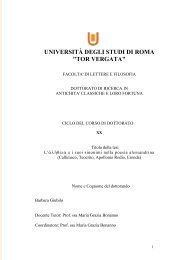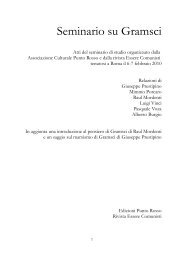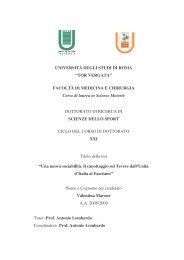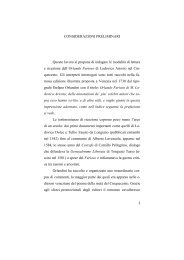Universitā degli studi di Roma “Tor Vergata” - ART - TORVERGATA ...
Universitā degli studi di Roma “Tor Vergata” - ART - TORVERGATA ...
Universitā degli studi di Roma “Tor Vergata” - ART - TORVERGATA ...
Create successful ePaper yourself
Turn your PDF publications into a flip-book with our unique Google optimized e-Paper software.
Kleiner and Rajani (2001A and 2001B) wrote a comprehensive review about the models<br />
used for quantifying the structural deterioration of water mains by analysing historical<br />
performance data. Such models are <strong>di</strong>vided in two groups: physical and statistical.<br />
The physical models are scientifically more robust because consider the real loads<br />
supported by the pipe and its mechanical resistance, but because they needed the huge amount of<br />
data, this approach is applied when the important consequences of pipe failures can justify the<br />
accumulation of such data.<br />
The statistical models with various levels of input data may be useful for minor water<br />
mains for which there are few data available or for which the cost of failure does not justify the<br />
amount and the quality of the required data. The statistical models assume that the historical<br />
patters can continue in the future, and the pre<strong>di</strong>ction can be done by:<br />
• deterministic models, that are either time-exponential models or time-linear<br />
models based on two or three parameters. They are applied on an homogeneous<br />
group of pipes that have to be selected carefully;<br />
• probabilistic multi-variate models consider many covariates (defined with<br />
awareness by an expert), that influence the pipe breakage patterns, and the<br />
selection of homogeneous groups it is not necessary. This kind of model can be<br />
useful for define a priority for rehabilitation;<br />
• probabilistic single-variate group-processing models, that include models that use<br />
probabilistic processes on grouped data to derive: probabilities of pipe life<br />
expectancy (useful for future financial needs), probability of breakage and<br />
probabilistic analysis of break clustering phenomenon (useful for short-term<br />
planning of water main rehabilitation and renewal).<br />
For example, the EN 752-5 formulates: “the investigation of the construction may<br />
comprise either a complete examination of the drainage system or a selective method”. Mueller<br />
(2003) argued out the benefit of random selection because it is convenient in terms of time and<br />
costs. Then the sewer network has to be grouped in quite homogeneous set accor<strong>di</strong>ng to the<br />
relevant characteristics to be considered.<br />
The number of the selected groups depend on heterogeneity of the urban area and the aim<br />
of the selective inspection is to infer from the <strong>di</strong>stribution of the classes of con<strong>di</strong>tion resulting<br />
from a representative random sample the <strong>di</strong>stribution of the classes of con<strong>di</strong>tion of specific<br />
groups of reaches (Mueller, 2003). These groups have to be small enough to be quite uniform but<br />
21



